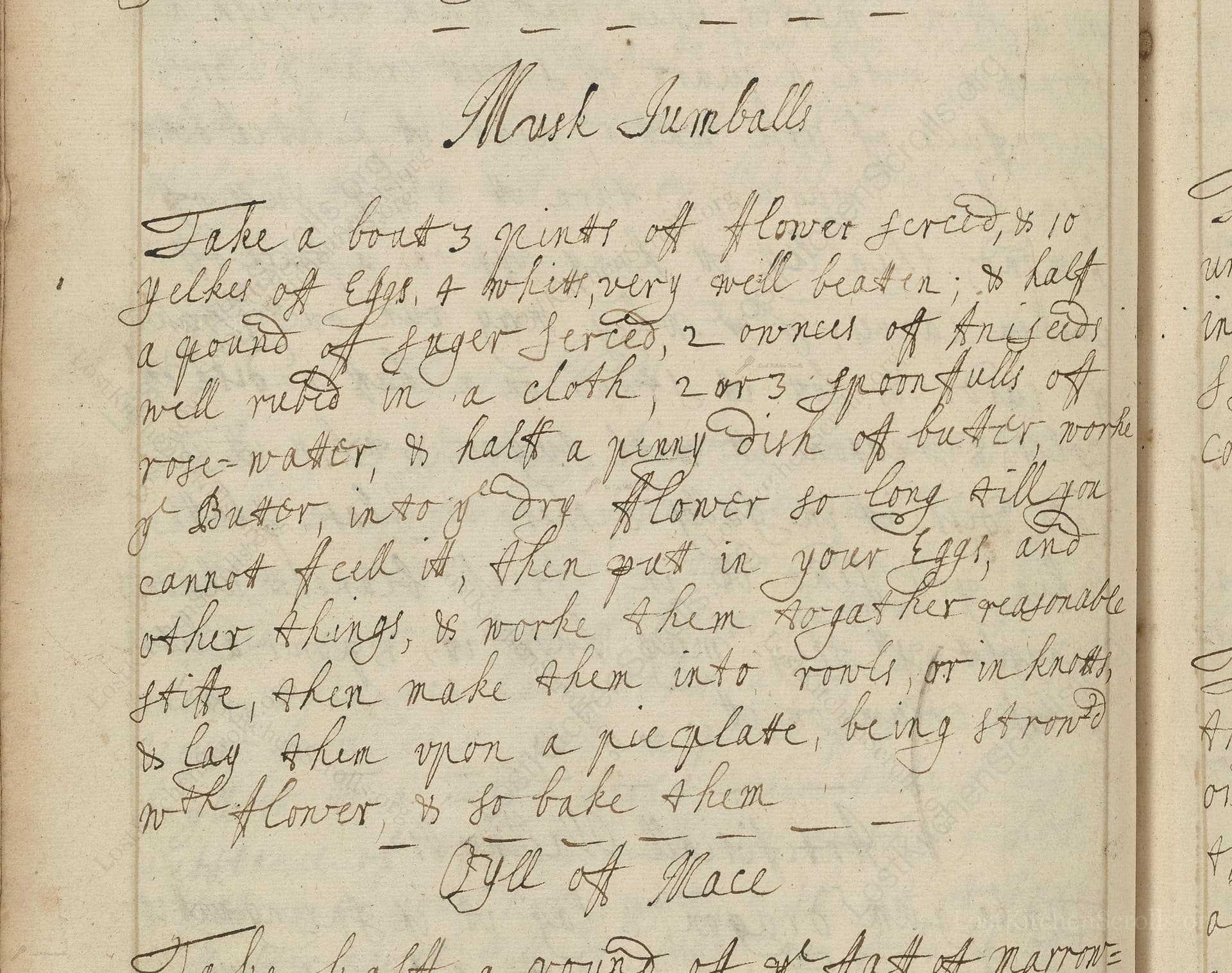Musk Jumballs
From the treasured pages of Receipt book of Mary Hookes
Written by Mary Hookes

Musk Jumballs
"Take 3 pints of flower serced, & 10 yelks of Eggs & the whits, very well beaten; & half a pound of suger serced, 2 ounces of Aniseeds well rub'd in a cloth, 2 or 3 spoonfulls of rose-water, & half a peny dish of butterr, worke it into dry flower so long till you canot feell it, then put in your Eggs, and other things, & worke them together reasonable stiffe, then make them into rowls, or in knotts, & lay them upon a pieplate, being strowd with flower, & so bake them"
Note on the Original Text
Early modern English recipes, like this one, often lack precise measurements and baking times, relying on the experienced eye and feel of the cook. Spellings are much closer to their spoken forms, with 'flower' for 'flour', 'serced' for 'sifted', and 'ylks' for 'yolks'. Quantities like 'half a peny dish' refer to the small coin-sized measure—a pinch or spoonful by today’s standards. This recipe lists ingredients in the order of use, blending instructions with the ingredient listing, making adept interpretation a mark of the skilled historical cook.

Title
Receipt book of Mary Hookes (1700)
You can also click the book image above to peruse the original tome
Writer
Mary Hookes
Era
1700
Publisher
Unknown
Background
A delightful voyage into the kitchens of the late 17th and early 18th centuries, this book teems with forgotten flavors, aromatic recipes, and the elegant wisdom of early modern cookery. A treasure trove for culinary adventurers craving a taste of the past!
Kindly made available by
Folger Shakespeare Library
Musk Jumballs were a fashionable treat in late 17th to early 18th century England, beloved for their perfumed flavors and decorative shapes. Recipes like this were often made in the homes of the well-to-do, hinting at a social world that prized unique flavors (like aniseed and rosewater) and aromatic additives such as musk, long since replaced by more accessible flavorings. This particular recipe is from the culinary manuscript of Mary Hookes, written between 1675 and 1725—a time when English baking was evolving with exotic imports and rich household traditions.

In Mary Hookes's kitchen, you’d have used a large wooden bowl for mixing, a sieve for sifting your flour and sugar, and a simple whisk (likely a bundle of twigs or hand-beaten) for your eggs. The dough would be kneaded on a wooden board, then shaped by hand into ropes and knots. Trays were often simple metal or earthenware pie plates, generously sprinkled with flour to prevent sticking, and baking took place in a wood-fired bread oven.
Prep Time
25 mins
Cook Time
12 mins
Servings
24
We've done our best to adapt this historical recipe for modern kitchens, but some details may still need refinement. We warmly welcome feedback from fellow cooks and culinary historians — your insights support the entire community!
Ingredients
- 3 pints (approximately 2.5 pounds) plain flour, sifted
- 10 large eggs
- 8 ounces caster sugar, sifted
- 2 tablespoons (about 0.5 ounce) whole aniseed, gently crushed
- 2-3 tablespoons rose water
- 1 ounce unsalted butter, softened
- Extra flour for dusting
Instructions
- To make Musk Jumballs, start by sifting about 3 pints (approximately 2.5 pounds) of plain flour.
- In a separate bowl, beat together 10 egg yolks and their whites until very light.
- Sift in 8 ounces (half a pound) of caster sugar.
- Grind 2 tablespoons (about 2 tablespoons, or 2 ounces) of whole aniseed between your palms in a clean cloth to release their aromatic oils.
- Add 2-3 tablespoons of rose water, and about 1 ounce (2 tablespoons, or half a penny dish) of softened unsalted butter.
- Mix the butter thoroughly into the flour with your hands until it’s fully incorporated and you no longer feel any lumps.
- Now combine the eggs, sugar, aniseed, and rose water into the flour mixture, kneading until you have a stiff but pliable dough.
- Shape the dough into small rolls or into decorative knots, as was fashionable.
- Place on a baking tray dusted with flour, and bake in a preheated oven at 350°F until just set and lightly golden, about 10-12 minutes.
Estimated Calories
140 per serving
Cooking Estimates
It takes about 25 minutes to prepare the ingredients, shape the dough, and get ready to bake. The baking itself takes about 10-12 minutes. Each baked jumball contains about 140 calories, and the recipe makes about 24 jumballs.
As noted above, we have made our best effort to translate and adapt this historical recipe for modern kitchens, taking into account ingredients nowadays, cooking techniques, measurements, and so on. However, historical recipes often contain assumptions that require interpretation.
We'd love for anyone to help improve these adaptations. Community contributions are highly welcome. If you have suggestions, corrections, or cooking tips based on your experience with this recipe, please share them below.
Join the Discussion
Rate This Recipe

Den Bockfisch In Einer Fleisch Suppen Zu Kochen
This recipe hails from a German manuscript cookbook compiled in 1696, a time whe...

Die Grieß Nudlen Zumachen
This recipe comes from a rather mysterious manuscript cookbook, penned anonymous...

Ein Boudain
This recipe comes from an anonymous German-language manuscript cookbook from 169...

Ein Gesaltzen Citroni
This recipe, dating from 1696, comes from an extensive anonymous German cookbook...
Browse our complete collection of time-honored recipes



